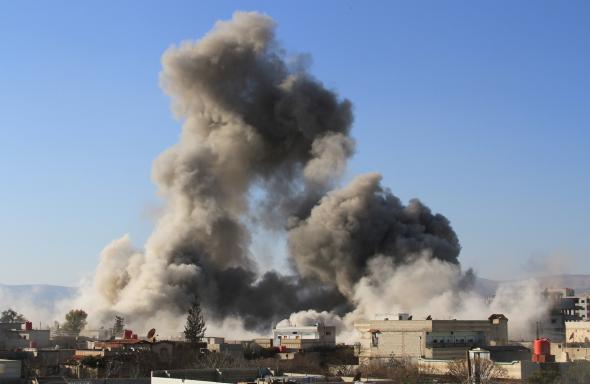Given all the international attention that has been focused on Syria’s chemical weapons stockpile, it seems almost like a cruel joke that the most brutally effective weapon in Bashar al-Assad’s arsenal these days consists of metal containers packed with TNT, nails, rebar, and machine scrap pushed manually out the back of a transport helicopter. While seemingly of little tactical value, these bombs are brutally effective at causing large amounts of destruction when dropped on civilian areas.
The New York Times reports today that the Syrian government’s policy of dropping “barrel bombs”—they are often, though not exclusively, made out of old oil drums—is a large part of what’s driving a massive exodus of refugees from rebel-held parts of Aleppo. As many as half a million people have been displaced to date in one of the largest refugee flows of the civil war, many crossing the border to Turkey.
Barrel bombs have been used in Syria since mid-2012 but in the past couple of months, the military seems to have settled on a uniform design for them. This isn’t to say that this is sophisticated technology.
An analysis posted by one munitions expert on Eliot Higgins’ Brown Moses blog—an essential clearinghouse for information on Syrian weaponry—argued that “it is evident from visual observations that there has been little to no quality control on these designs because of the many shapes and sizes that have been observed. There appears to be clear design trends that clearly show that Syrian personnel have no weapon design and effects training.” In other words, they’re far less effective than conventional bombs.*
All the same, they have the advantage of being cheap to make, easy to deliver, and by all accounts absolutely terrifying to the people under them.
“When people hear a helicopter in the air, they expect a barrel bomb. The streets become empty and everyone runs to hide. They just hide waiting for their death,” one Aleppo-based activist told the Associated Press. “The barrels are huge and very heavy, so when they fall you hear this sound like they’re tearing through the air. I don’t know how to describe it.”
Max Fisher of the Washington Post argued recently that it’s the very crudity of the barrel bombs that makes them so terrifying. They affirm that the “regime is interested in no path forward other than by killing.”
In that respect, there is another parallel with chemical weapons. Both have limited tactical value on the battlefield, but are very effective at killing large numbers of civilians as efficiently as possible. Both are a clear signal to Syria’s civilian population of lengths that the regime is willing to go to, but unlike with chemical weapons, Assad appears in no danger of incurring international intervention by dropping barrels full of scrap metal on his own people.
*Correction, Feb. 18, 2013: This post originally misspelled Eliot Higgins’ first name.
